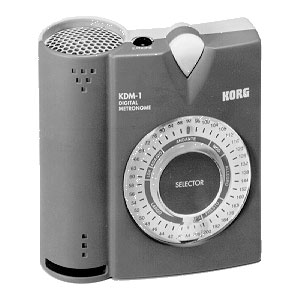Note: this post was first published in my other blog in March 2009, but I thought it relevant to be included here.
Wikipedia defines a metronome as
…any device that produces a regulated aural, visual or tactile pulse to establish a steady tempo in the performance of music. It is a useful practice tool for musicians that dates back to the early 19th century. The mechanical metronome was invented by Dietrich Nikolaus Winkel in Amsterdam in 1812. Johann Mälzel copied several of Winkel’s construction ideas and received the patent for the portable metronome in 1816. Ludwig van Beethoven was the first notable composer to indicate specific metronome markings in his music, in 1817.
Musicians use the metronome during practicing in order to attain a constant tempo (or speed). Tempo is measured in beats per minute, or BPM. Metronomes can be set to any tempo the performer chooses, usually between 40 to 208 BPM. Mechanical metronomes have been around the longest, but they do have some shortcomings:
- They aren’t particularly accurate at the extreme ends of slow and fast tempos, due to their mechanical makeup.
- They need the performer to periodically wind it up, just like a mechanical clock.
- They are sensitive to extremes of temperature, and also to humidity.
- For some strange reason, even if you take very good care of it, mechanical metronomes just fail to tick properly after some time. In other words, the ticking becomes uneven and inaccurate.
I’ve owned a couple of mechanical metronomes before, a long time ago. When electronic metronomes saw the light of day, I was one of the first to acquire one, a Wittner Taktell, which was powered by a 9V battery and had a flashing red light. Then later on, in 2000 I think, I happened to see the Korg KDM-1 at a music store here, and it impressed me with its loud sound (students sometimes complained to me that they couldn’t hear the Taktell’s sound over their own playing). Moreover, the KDM-1 had its own volume control, which was a definite plus. It also had an earphone jack, though I wouldn’t recommend you use it for blasting the ticking sound directly into your eardrums. It could last about 70 hours, powered by only a 9V battery.
When Korg announced the successor to the KDM-1, known simply as the KDM-2, I was ecstatic. It was like a KDM-1 on steroids, being just slightly wider and 40 grams heavier. Here’s the plethora of features it possesses (taken from the Korg website):
• Korg’s original, cylindrical resonator speaker provides powerful sound, now with even more volume and improved tone.
• An LED provides visual confirmation of the tempo, a convenient feature for practicing with the metronome muted.
• Newly added beat variations range from basic to sophisticated rhythms like son clave and rumba clave
• A total of 19 beat patterns cover your practicing needs in numerous musical styles.
• Tap Tempo function makes it easy to set the tempo.
• An audible Reference tone in a range of C4 to B4 is available, allowing you to tune your instrument.
• An encoder-type TEMPO/CALIB dial and switch provide direct access to the desired setting or function.
• A large LCD screen makes settings easy to see.
• Original and compact style.
• Long battery life (4 AAA’s), with approximately 120 hours of continuous use.
The KDM-1 had served me well for quite a few years without any trouble, so I sold it off to a student of mine and bought the KDM-2, which was a steal at $35 USD. This concludes my metronome odyssey. Needless to say, I await the KDM-3 with baited breath!
P/S Perhaps those clever wunderkinds in Korg could incorporate a female voice counting out the beats in the KDM-3. That would be cool!


Leave a Reply to Eng Ying Xuan Cancel reply